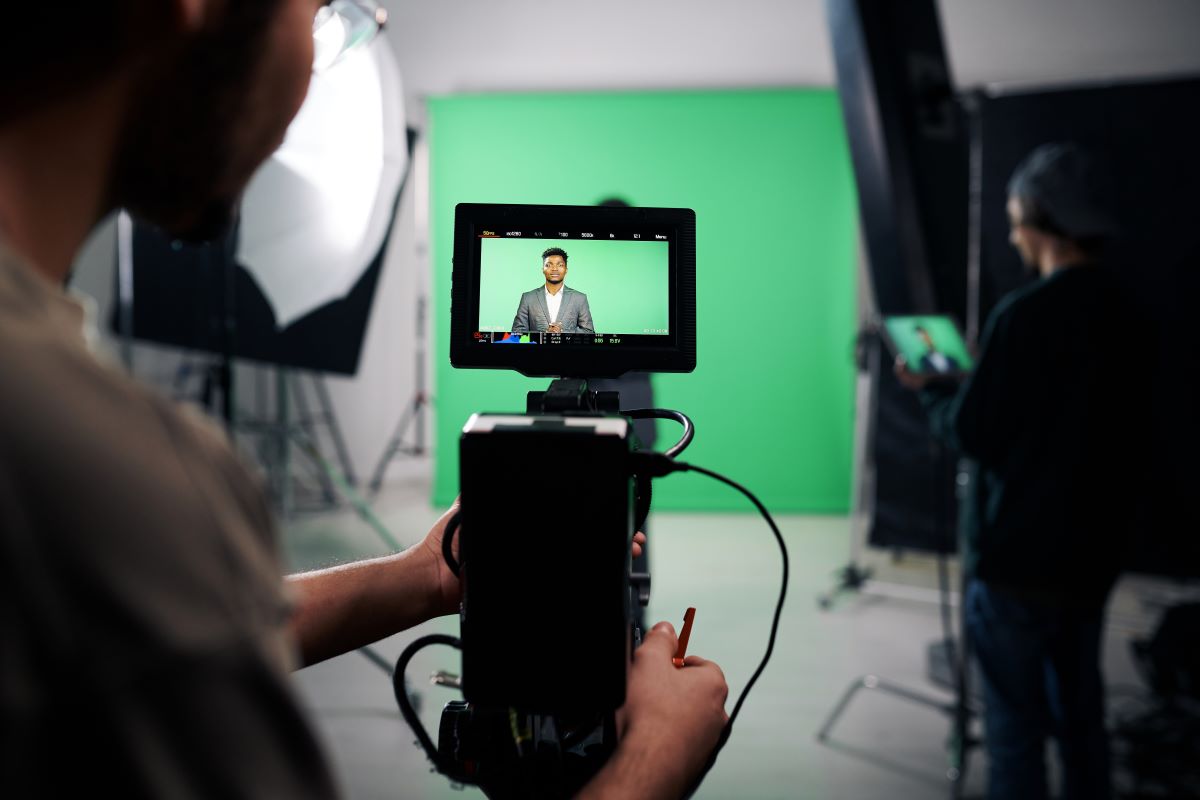
Video Production Firm: Green Screen Backgrounds
In 2010, The Weather Channel faced an awkward moment during a live broadcast. The meteorologist was explaining a severe storm when viewers noticed parts of her green dress disappearing into the background map. This humorous mishap quickly went viral, highlighting just how much can go wrong when green screen technology is misused—even in the hands of professionals. What was meant to convey life-saving information ended up as a cautionary tale for improper planning and wardrobe choices in video production. Stories like these emphasise the power and pitfalls of green screen technology. When used correctly, it can create stunning visuals and immersive environments. But even minor oversights can derail a project, turning what should be professional and polished into a memorable blunder for all the wrong reasons. In this article, we will explore the essentials of green screen technology and its role in video production. We will discuss what a professional video production firm uses it for, the science behind it, common mistakes to avoid, and how to determine if it is the right fit for your project.
What is a Green Screen Background?
A green screen background, also known as chroma key, is a visual effects technique that allows filmmakers to replace the green backdrop with any digital image or footage during post-production. This background colour is chosen because it is distinct from skin tones and most clothing, making it easy for editing software to differentiate between the subject and the background. Essentially, a green screen serves as a blank canvas, enabling a video production firm to create anything from realistic outdoor environments to surreal, otherworldly landscapes.
What Does A Video Production Firm Use Green Screens For?
Video production companies primarily use green screens to create immersive environments that would be either too expensive or impossible to capture with traditional filming methods. Some common uses include:
- Virtual sets and environments: Green screens allow filmmakers to create expansive digital worlds or futuristic settings without needing large physical sets. This is frequently seen in blockbuster films and TV shows like Game of Thrones.
- Weather forecasts: Green screens are often used in broadcasting to display weather maps behind meteorologists during live television broadcasts.
- Product demos and marketing videos: For companies looking to highlight their products without needing physical props or setups, a green screen offers the flexibility to place items in custom, eye-catching digital environments.
- Training and educational videos: Green screens are also useful in corporate training videos, where instructors can appear in diverse locations without leaving the studio.
The Science Behind Green Screen Technology
Green screen technology is built around the principle of chroma keying, a process that uses digital tools to remove one colour (in this case, green) and replace it with another. The background colour is specifically chosen because it does not often appear in human skin tones, hair, or most clothing, making it easier to isolate. For the best results, the green screen must be evenly lit, and the subject must be placed far enough from the screen to prevent unwanted shadows or light spill.
The Keying Process: How It Works
The keying process involves several technical steps that a video production firm employs during post-production:
- Selection of the colour: Software like Adobe After Effects or Final Cut Pro identifies and removes the chosen colour—in this case, green.
- Refining the edges: The software fine-tunes the edges of the subject to ensure no green fringe remains. This step is crucial to making the composited footage look realistic.
- Background replacement: Once the green is removed, a new digital background is inserted, and the subject is placed in this virtual environment. This process allows for the seamless integration of visual elements that were not physically present during filming.
Do’s and Don’ts of Green Screen Backgrounds
Green screen technology is incredibly versatile, but it comes with its own set of challenges. A skilled video production firm knows the key do’s and don’ts to avoid common mistakes and deliver professional, polished footage:
Do’s:
- Ensure even lighting: Properly lit green screens are vital for a clean key. Uneven lighting can result in shadows or colour discrepancies that are difficult to fix in post-production. Multiple light sources should be used to illuminate the screen evenly.
- Use distance wisely: Subjects should be kept several feet away from the green screen to avoid green spill—unwanted reflections of green light on the subject. This helps ensure a cleaner separation between the subject and the background.
- Test your shots: Before shooting, a video production firm would test different lighting setups and angles. Experimenting with different shots during pre-production can save a lot of time and effort later in post-production.
Don’ts:
- Avoid wearing green: If a subject wears green, part of their clothing will be keyed out, leading to awkward results. Always ensure that clothing contrasts with the green screen colour.
- Do not skip post-production adjustments: Even if the lighting is perfect, keying often requires some adjustments. A skilled video production firm never assumes the software will handle everything perfectly. An editor is essential to refine the final look.
- Do not rush the setup: Rushing the setup phase can lead to problems in the final video, such as poor keying or shadows. A professional video production firm takes the time to measure and position both the green screen and the subject to ensure the best possible result.
How to Decide if Green Screen is Right for Your Project
While green screen technology can elevate many types of videos, it may not always be the right choice for every project. Here is how to decide:
- Consider the environment: If the scene requires a dynamic, realistic environment that would be costly or impractical to shoot in real life, a green screen might be the best solution.
- Assess the complexity: For simple corporate videos or straightforward product shots, a green screen may not be necessary. However, for complex scenarios—such as virtual events, sci-fi movies, or video games—green screen technology can be a game changer.
- Budget and time: While green screens can save money by avoiding the construction of elaborate sets, the post-production process can be time-consuming and costly if not handled by experts. Assess your budget and timeline before opting for this method.
Successful and Unsuccessful Applications of Green Screen
While green screen technology has led to incredible results in many high-profile productions, there are also notable failures that underscore the importance of proper execution.
Successful Case Study: The Mandalorian, the Star Wars spin-off series, used green screen technology in an innovative way by combining it with LED panels for real-time background rendering. This hybrid technique created realistic, immersive environments that transported viewers to alien worlds without the need for traditional green screen compositing, improving both production speed and quality.
Unsuccessful Case Study: A 2020 live-streaming event by a prominent video game company faced backlash due to poor green screen execution. The broadcast suffered from uneven lighting, visible shadows, and green spill on the interviewees, which detracted from the overall production quality. This case highlights the critical importance of proper lighting, positioning, and post-production refinement. It is a reminder of the importance of working with a video production firm that not only has access to the latest technology but also understands how to implement it effectively. What good is having the tools if you can not use them?
Final Thoughts
Green screen technology has come a long way since its first use in Hollywood films in the 1930s. Today, it is a staple in almost every genre, from blockbuster movies to live-streaming events and even corporate videos. But as we have seen, the success of this technique does not just rely on having the right equipment—it is about having a team that knows how to use it. With proper lighting, expert positioning, and a keen eye during post-production, the results can be magic.
Take, for instance, the making of Avatar. James Cameron’s groundbreaking film pushed the limits of green screen use, blending virtual environments with live action to create one of the most immersive cinematic experiences. Behind the scenes, a team of experts worked tirelessly to perfect the lighting, positioning, and camera work. This was not just about technology—it was about understanding how to use it.
The takeaway? Green screen can be a powerful asset, but its success depends on the hands that guide it. A video production firm that understands the nuances of this technology will ensure your project is not just another green screen fail, but a polished final product that delivers on your vision. After all, the most innovative tools in the world are only as good as the people using them.
Ready to make the most of your green screen project? Let Sound Idea Digital guide you through the process. Contact us today, and we’ll make sure everything is set up for success.
We are a full-service Web Development and Content Production Agency in Gauteng specialising in Video Production, Animation, eLearning Content Development, Learning Management Systems, and Content Production.
Contact us for a quote. | enquiries@soundidea.co.za | https://www.soundideavideoproduction.co.za| +27 82 491 5824 |

